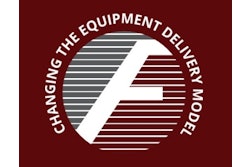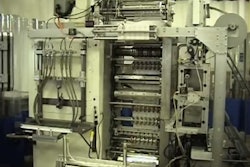Rather than invest in new equipment, Avail Medical, a contract packager of medical and pharmaceutical products, chose to refurbish an existing vertical form/fill/seal machine at its Dallas, TX, plant.
Originally used to package packets of nasal strips, the six-up machine now dispenses an antiseptic solution onto a folded pad that’s inserted into each 2” x 2” packet, then seals the packets. Cartoned packets are cased and shipped off to Avail’s customer for distribution to hospitals and clinics.
The poucher was rebuilt and upgraded by the Cartpac (Carol Stream, IL) division of Frain Industries with a number of new features and custom components, such as the unwind and feeding assemblies for the pad and film webs and the pad folding/inserting mechanism. It also includes new controls, including the movable human-machine touchscreen interface. Additionally, throughput rates were doubled to 60 cycles/min.
The latest upgrades follow earlier improvements made by Cartpac in 1998. The reasoning was the same for both rounds—better utilization of existing machinery by making the current machine more productive—according to Mike Ewald, Avail’s vice president of business development. These latest advances bring the machine, built circa 1985, up to 2002 standards and custom-fit it to Avail’s current business plans. Started up in October 2001, the machine is dedicated to a single product for one customer.
Six-up packeting
Dressed up with fresh paint, the vf/f/s machine is housed inside an area isolated by plastic curtains. The packets are formed six across from preprinted foil-laminated rollstock via unwind and dancer stations on the side of the machine. Product lot coding and expiration date coding are applied by three rack-mounted thermal-transfer printers. A knife slits the film web in half to create the front and back webs used for the packets. The two webs are separated, are folded over in a 90 degree turn, travel in opposite directions, and then come together vertically down at the center of the machine.
The laminate is side-sealed as the pad material—which is slit from a roll, cut, and folded—is inserted between the front and back webs. The Cartpac-added devices first unwind and slit the roll of nonwoven pad material into six 11/8’’-wide strips. Before insertion into the packets, the pad strips pass beneath a vacuum header that removes any lint. Each strip is folded into a pad and inserted into the packet by a new reciprocating-motion servo drive.
The entire pad system is custom. “It would have been more costly to modify a new machine to this configuration,” Ewald points out.
Liquid learning curve
An antiseptic solution is then injected into the packets via the newly modified liquid fill system. As part of the 1998 upgrades, Cartpac had adapted the nonliquid vf/f/s machine to liquid filling. Ewald says this was when the company experienced the biggest learning curve: “We have other machines more advanced than this, but this was our first foray into liquid filling.”
Added were a positive displacement pump, flexible tubing, and six 36’’-long metal filling tubes. The delivery dose for each tube can be set independently or as an integrated setup that allows single setting of all six fill volumes, which is how Avail uses it. Fill dosage is a minimum of 0.85 grams using a target of about 1 gram. Avail mechanical engineer John Quay says the fill volume is “very accurate.” Modifications made in the most recent upgrades adapt the system to handle the antiseptic solution.
After filling, packets are individually perforated and a notch is die cut in the side for easy tear opening; both of these operations are new. Unlike a tear cut, the notching produces an easier-to-use diamond shaped cut.
The packets are cross-cut into rows of six that drop onto a 10’-long inclined takeaway conveyor equipped with a pressure roller that tests the packets for bad seals. The roller pressure causes a defective seal to burst the packet; the dark antiseptic solution provides a tell-tale indication, and the packets are manually removed.
A Cartpac-designed automatic counting interface slows down the conveyor between each group of 16 packets to create a gap. That makes it easy for the operators to see and assemble the proper counts. “That works great,” Ewald remarks. Operators then pack 16 six-count strips—adding four packets to bring the count to 100—into an SBS paperboard carton. Since the poucher is dedicated to the one size of packet, machinery changeover isn’t needed.
Refurbished twice
As Avail’s business plans evolved, so did its plans for the poucher. The poucher had been underutilized, even following the 1998 reconditioning and upgrades made by Cartpac. In fact, the machinery had remained largely unused since that time. Reports Ewald: “If it was feasible, it made more sense to make better use of idle equipment than to buy another machine.”
Rather than send the machine back to the poucher OEM for the upgrade, Avail felt the support and resources would be better at Cartpac.
For the latest upgrades, the machine was shipped to Cartpac in October ’00 and returned in April ’01. Ewald says the time would have been shorter except for factors that were outside Cartpac’s control, including packaging materials issues.
The upgrades totaled $180ꯠ, which is inclusive of all costs including shipping. That brought Avail’s total investment in the machine to around $350ꯠ.
Justification for the upgrades was a matter of comparing the cost of a new machine with the total investment in the used poucher. “Initially we’d thought that there would be a cost advantage, but the total costs ended up the same as buying a new machine,” Ewald says.
As to the poucher’s performance, Ewald reports “so far, so good. This is our first venture with this particular customer, and the poucher’s capability will allow us to expand our business with them.”
Under the right circumstances, refurbished equipment can be a viable option, Ewald says, “if it helps with underutilized capacity. In fact, if things go as planned, we will profit from these changes.”
Avail already has its sights set on further upgrades, which would be the third for this machine, to increase the output by 50% by expanding to nine-up filling.
See WEB EXCLUSIVE sidebar to this story: Avail’s upgrades up close


























